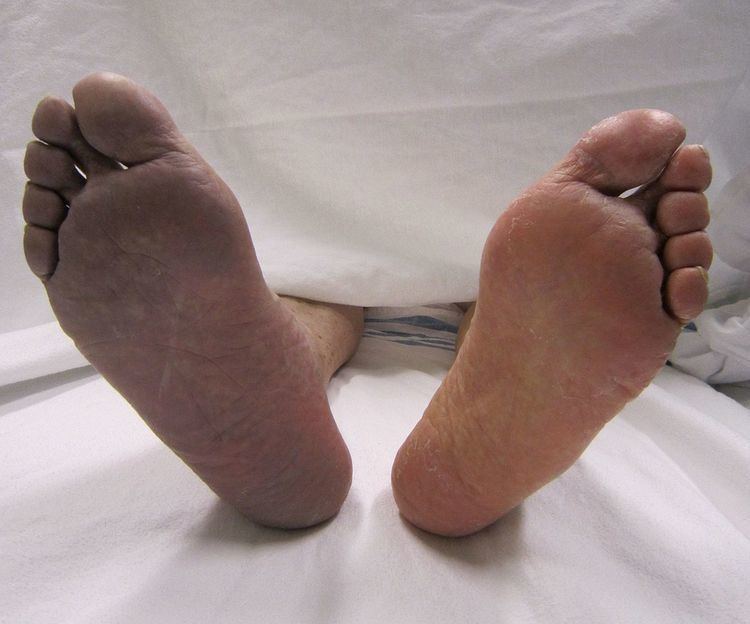Synonyms acute limb ischemia DiseasesDB 7480 | ICD-9-CM 459.9 | |
 | ||
Acute limb ischaemia (ALI) occurs when there is a sudden lack of blood flow to a limb.
Contents
- Signs and symptoms
- Related conditions
- Diagnosis
- Surgery
- Medications
- Mechanical thrombolysis
- Considerations in treatment
- Epidemiology
- References
Acute limb ischaemia is caused by embolism or thrombosis, or rarely by dissection or trauma. Thrombosis is usually caused by peripheral vascular disease (atherosclerotic disease that leads to blood vessel blockage), while an embolism is usually of cardiac origin. In the United States, ALI is estimated to occur in 14 out of every 100,000 people per year. With proper surgical care, acute limb ischaemia is a highly treatable condition; however, delayed treatment (beyond 6 to 12 hours) can result in permanent disability, amputation, and/or death.
The New Latin term ischaemia as written, is a British version of the word ischemia, and stems from the Greek terms ischein 'to hold'; and haima 'blood'. In this sense, ischaemia refers to the inhibition of blood flow to/through the limb.
Signs and symptoms
Acute limb ischaemia can occur in patients through all age groups. Patients that smoke and have diabetes mellitus are at a higher risk of developing acute limb ischaemia. Most cases involve people with atherosclerosis problems.
Symptoms of acute limb ischaemia include:
These symptoms are called "the six P's'"; they are commonly mis-attributed to compartment syndrome. One more symptom would be the development of gangrene. Immediate medical attention should be sought with any of the symptoms.
Related conditions
When a limb is ischemic in the non-acute (chronic) setting, the condition is alternatively called peripheral artery disease or critical limb ischemia, rather than ALI. In addition to limb ischemia, other organs can become ischemic, causing:
Diagnosis
In order to treat acute limb ischaemia there are a series of things that can be done to determine where the occlusion is located, the severity, and what the cause was. To find out where the occlusion is located one of the things that can be done is simply a pulse examination to see where the heart rate can be detected and where it stops being sensed. Also there is a lower body temperature below the occlusion as well as paleness. A Doppler evaluation is used to show the extent and severity of the ischaemia by showing flow in smaller arteries. Other diagnostical tools are duplex ultrasonography, computed tomography angiography (CTA), and magnetic resonance angiography (MRA). The CTA and MRA are used most often because the duplex ultrasonography although non-invasive is not precise in planning revascularization. CTA uses radiation and may not pick up on vessels for revascularization that are distal to the occlusion, but it is much quicker than MRA. In treating acute limb ischaemia time is everything.
In the worst cases acute limb ischaemia progresses to critical limb ischaemia, and results in death or limb loss. Early detection and steps towards fixing the problem with limb-sparing techniques can salvage the limb. Compartment syndrome can occur because of acute limb ischaemia because of the biotoxins that accumulate distal to the occlusion resulting in edema.
Surgery
The primary intervention in acute limb ischaemia is emergency embolectomy using a Fogarty Catheter, providing the limb is still viable within the 4-6h timeframe. Other options include a vascular bypass to route blood flow around the clot.
Medications
Those unsuitable for surgery may receive thrombolytics. In the past, streptokinase was the main thrombolytic chemical. More recently, drugs such as tissue plasminogen activator, urokinase, and anisterplase have been used in its place. Mechanical methods of injecting the thrombolytic compounds have improved with the introduction of pulsed spray catheters—which allow for a greater opportunity for patients to avoid surgery. Pharmacological thrombolysis requires a catheter insert into the affected area, attached to the catheter is often a wire with holes to allow for a wider dispersal area of the thrombolytic agent. These agents lyse the ischemia-causing thrombus quickly and effectively.
Mechanical thrombolysis
Another type of thrombolysis disrupts the clot mechanically using either saline jets or, more recently, ultrasound waves. Saline jets dislodge the clot using the Bernoulli effect. Ultrasound waves, emitted at low frequency, create a physical fragmentation of the thrombus.
Considerations in treatment
The best course of treatment varies from case to case. The physician must take into account the details in the case before deciding on the appropriate treatment. No treatment is effective for every patient.
Treatment depends on many factors, including:
Epidemiology
The major cause of acute limb ischaemia is arterial thrombosis (85%), while embolic occlusion is responsible for 15% of cases. In rare instances, arterial aneurysm of the popliteal artery has been found to create a thrombosis or embolism resulting in ischaemia.
